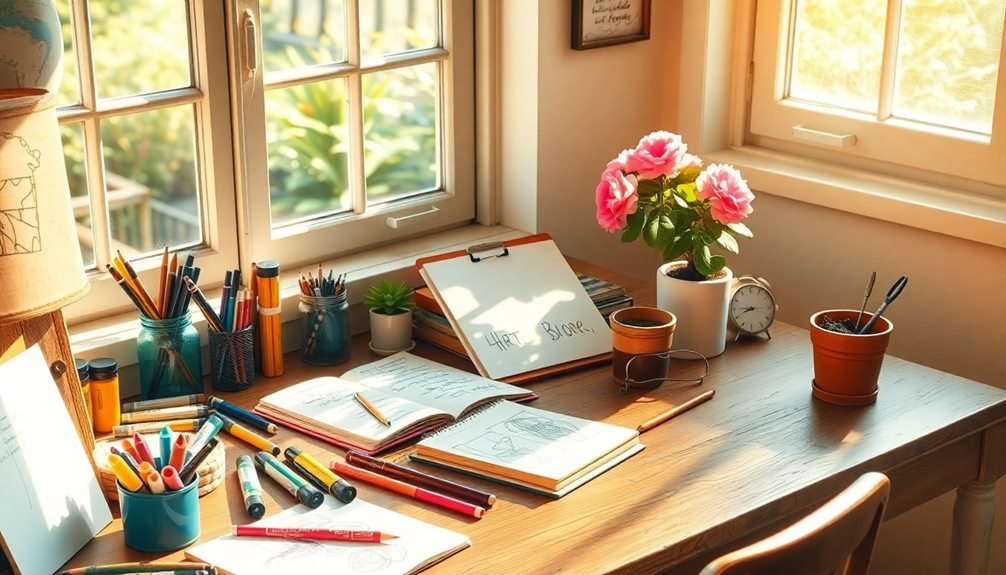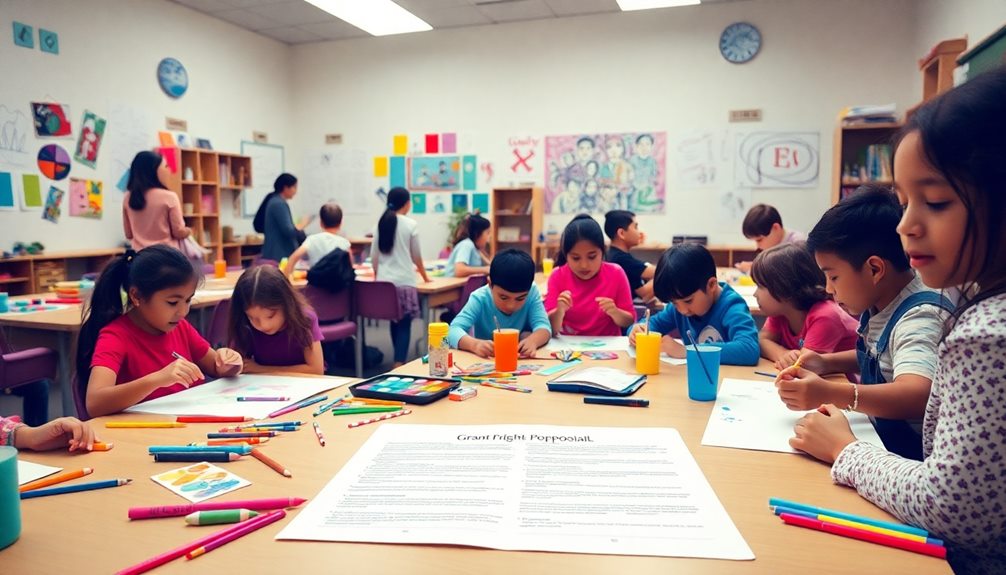Networking in the art world is essential for your success and visibility. It helps you forge relationships that can lead to exhibitions, sales, and collaborations. Engaging with fellow artists and industry professionals not only enhances your opportunities but also fosters a supportive community. By attending art events, workshops, and utilizing social media, you can expand your network and connect with potential buyers and mentors. Building authentic connections increases your chances of recognition and enhances your artistic journey. If you explore further, you'll discover effective strategies and tips to maximize your networking efforts.
Key Takeaways
- Networking is essential for artists to build relationships that lead to exhibitions, collaborations, and increased visibility in the art world.
- Engaging in casual conversations can uncover opportunities for art sales and freelance gigs through personal connections.
- Attending art shows and events increases visibility and opens doors for mentorship roles and display opportunities.
- A strong online presence on platforms like Instagram helps artists connect with peers and collectors beyond geographic limitations.
- Building a supportive community through artist collectives fosters mutual encouragement and resource sharing among creatives.
Importance of Networking for Artists

Networking plays an essential role in an artist's journey, helping you forge relationships that can open doors to exhibitions, collaborations, and career growth. In the competitive art world, it's not just about talent but also the connections you make. Studies show that artists with diverse networks are statistically more likely to achieve fame, highlighting the importance of social connections.
Engaging in networking activities, whether through gallery openings or social media, creates a sense of community that counters the often solitary nature of artistic work. This community can enhance your overall well-being and provide invaluable support during challenging times.
Familiarity with collectors and gallery owners increases your chances of making art sales, as personal relationships lead to genuine support rather than pity purchases.
Moreover, networking grants you access to valuable resources, mentorship, and insights into current art trends. These elements are vital for emerging artists like you seeking visibility and success.
Artistic and Creative Advancement

Building connections in the art world not only opens doors but also greatly contributes to your artistic and creative growth. Attending a networking event allows you to meet fellow artists who can inspire you and introduce fresh perspectives.
By engaging with diverse viewpoints, you can enhance your artistic experimentation, leading to innovative bodies of work that you mightn't achieve on your own.
When you collaborate on a project with peers, you not only share ideas but also solve niche artistic problems together. This knowledge-sharing creates a support system that nurtures your development.
The relationships you build can lead to unexpected job offers and freelance opportunities, expanding your career prospects.
Moreover, healthy relationships within the art community foster mutual support and inspiration. This encouragement not only enhances your overall well-being but also pushes you to continue evolving as an artist.
The connections you make can lead to exciting collaborations and creative breakthroughs that enrich your practice.
Opportunity Creation and Sales

When you engage in casual conversations at networking events, you might discover display opportunities that boost your visibility and sales.
By building rapport with other artists and collectors, you create a foundation of trust that encourages support for your work.
These genuine connections can lead to unexpected opportunities that drive your art sales forward.
Casual Conversations Lead Sales
At art events, casual conversations can spark unexpected opportunities for sales and collaborations. When you engage in relaxed discussions, you open doors to showcasing your work at local venues, reaching new audiences who mightn't have discovered you otherwise.
Networking in this way not only helps you find potential buyers but can also lead to job offers and freelance gigs that align with your skills.
Building relationships with fellow artists fosters a supportive environment where everyone can thrive. As you connect with others, you create a network that encourages mutual sales support, expanding each artist's customer base.
Familiarity and likability play an essential role here; when buyers feel a personal connection to you and your work, they're more likely to show genuine interest rather than make pity purchases.
Engaging in authentic conversations about your experiences and artistic journeys can create an atmosphere ripe for sales opportunities. Positive interactions often lead to collaborations and support, making those casual conversations not just small talk but a significant part of your sales strategy.
Building Rapport for Sales
Establishing rapport with fellow artists and potential buyers can greatly boost your sales potential. When you create genuine connections, you foster an environment where art is appreciated, not just bought. This familiarity and likability make it easier for you to communicate the value of your work, enhancing the likelihood of sales.
To effectively build rapport, consider these strategies:
- Engage authentically: Show genuine interest in others' work and experiences, which encourages them to reciprocate.
- Utilize casual conversations: These interactions can lead to unexpected opportunities, like display options or mentorship roles that enhance your visibility.
- Create a supportive environment: By engaging with the art community, you foster mutual support that expands your customer base.
Networking Events Generate Opportunities
Networking events serve as powerful catalysts for opportunity creation in the art world. When you attend these events, you're not just mingling; you're actively increasing your visibility and opening doors to display opportunities at local venues. This exposure can greatly boost your potential sales, transforming casual conversations into meaningful relationships that can enhance your career.
Engaging with fellow artists often leads to fruitful connections, where you share networks and support each other's work. These interactions foster genuine interest in your art, creating an environment that encourages sales based on authentic appreciation rather than mere pity purchases.
Plus, you might find yourself stepping into teaching or mentorship roles, which can diversify your income streams while elevating your profile in the art community.
As you cultivate these relationships, you'll likely experience more support from buyers who resonate with your story and artistic vision. The connections you develop at networking events not only expand your customer base but also create a network of advocates enthusiastic to promote your work.
Embrace these opportunities, and watch your art career flourish.
Strategies for Effective Networking

In the art world, effective networking can open doors to new opportunities and collaborations. To make the most of your networking efforts, consider these strategies.
Attend art shows, workshops, and industry events regularly. These gatherings not only enhance your visibility but also allow you to meet new people and exchange ideas.
A strong online presence is essential, so showcase your artwork on social media platforms like Instagram and Twitter to connect with other artists and art enthusiasts.
Here are some key networking tips to keep in mind:
- Prepare your elevator pitch: Research attendees ahead of time and craft a concise message that communicates your artistic vision.
- Join artist collectives: Being part of organizations can provide a supportive community for sharing resources and networking.
- Follow up promptly: Reach out to new contacts within 24 hours, referencing your conversation to maintain relevance and build ongoing relationships.
Overcoming Networking Challenges

While building connections in the art world can be rewarding, it often comes with its own set of challenges. If you're introverted, you might find networking tough. However, practicing small talk and engaging in conversations can greatly boost your confidence.
Recognizing signs of stagnation in your networking efforts is essential for initiating change, and don't let fear of rejection hold you back; remember the potential benefits of networking can motivate you to connect with potential clients and peers emotional entanglements can hinder personal growth.
Time constraints can also be a barrier. Prioritizing key events and contacts helps you maximize your effectiveness and guarantees meaningful interactions.
If you face geographic limitations, consider virtual networking opportunities. These platforms allow you to connect with industry professionals and fellow artists regardless of where you are.
Lastly, focus on cultivating relationships over time instead of seeking immediate gains. This approach fosters a supportive network and encourages mutual assistance among peers.
By addressing these networking challenges head-on and adopting a proactive mindset, you'll not only enhance your social networking skills but also build lasting connections that can enrich your art career.
Historical Context in Networking

When you look at the history of art, you'll notice that networking practices have shaped many artists' careers.
From Picasso's connections to the overlooked struggles of female artists and artists of color, recognition often hinged on social ties rather than just talent.
Understanding these dynamics helps you appreciate how historical networking influences today's art world.
Historical Networking Practices
Salons in 18th-century Paris served as vibrant hubs where artists, collectors, and patrons mingled, exchanging ideas and forming fundamental connections.
These networking practices were critical for artists looking to build a network that would elevate their work and guarantee visibility in a competitive environment.
Prominent figures like Pablo Picasso thrived in these social settings, leveraging their relationships to foster collaboration and gain recognition.
However, not everyone had equal access to these opportunities. Female artists and artists of color often faced substantial barriers, limiting their participation in influential circles.
The importance of networking in the art world can't be overstated. It often proved to be as essential as an artist's talent.
Consider these points:
- Connections can lead to exhibition opportunities.
- Collaborations often enhance creative output.
- A robust social network can amplify visibility and support.
As you explore historical networking practices, remember that while talent is indispensable, the relationships you cultivate can greatly impact your artistic journey.
The complexities of visibility highlight how social networks can sometimes overshadow actual contributions, shaping the narrative of success in the art community.
Impact on Recognition
In the art world, recognition often hinges on the strength of one's network rather than just talent alone. Historically, artists like Pablo Picasso exemplified this, using social connections to catapult themselves into the limelight. Your ability to navigate social circles can greatly impact your visibility and acknowledgment as an artist.
Unfortunately, systemic challenges have often sidelined female artists and artists of color, with their recognition overshadowed by historical biases and limited access to influential networks.
Take Dora Maar, for example. Despite her immense talent, her contributions were largely overlooked due to her association with more prominent figures. This illustrates how social networking can dictate the acknowledgment of artistic merit.
A study by Columbia University and HEC Paris underscores this point, showing that artists with diverse social connections are statistically more likely to achieve fame.
In essence, the art world often prioritizes reputation and social ties over the intrinsic quality of your work. To enhance your recognition, it's essential to cultivate a robust network that can open doors and elevate your career, reminding you that who you know can be just as important as what you create.
Reputation and Quality Dynamics

Reputation often trumps quality in the contemporary art world, shaping how audiences perceive and value an artist's work. This phenomenon can be further illuminated through the lens of art practice and theory, as artists navigate the complexities of both their creations and their public personas.
Take Marcel Duchamp's "Fountain," for example; it challenged traditional notions of taste and artistic merit, illustrating that an artist's reputation can sometimes overshadow the quality of their creations. As you navigate this landscape, understanding the dynamics of reputation and networking is essential.
Consider these key points:
- Early exhibitions can greatly boost an artist's reputation, paving the way for future success.
- Prestigious venues and high-profile shows enhance visibility, making it easier to sell and sustain your career.
- Artists with established reputations are statistically more likely to gain recognition than those who focus solely on their artwork's quality.
In this competitive environment, your social connections matter. Building a robust network can elevate your visibility and marketability, making it more likely for your work to be appreciated and valued.
Building Community in the Arts

Artistic success often hinges on the connections you foster within the community. Networking can help you combat the isolating nature of artistic work while promoting collaboration. Engaging with fellow artists lets you share resources, techniques, and inspiration, enhancing your creative practice and collective growth.
Participating in art events, workshops, and collectives is essential for expanding your social networks. Through these interactions, you gain visibility and stay updated on current trends. Building a supportive creative community not only nurtures your well-being but also facilitates career advancement through partnerships and exhibition opportunities.
Here's a quick look at how building community can benefit you:
| Benefits | Examples |
|---|---|
| Emotional Support | Sharing experiences with peers |
| Resource Sharing | Collaborating on projects |
| Career Advancement | Finding new exhibition venues |
| Increased Opportunities | Gaining commissions and sales |
Art Promotion Techniques

To effectively promote your art, you need to leverage social media and create a professional website.
Platforms like Instagram can showcase your work and connect you directly with potential buyers, while a well-designed website builds your credibility.
Social Media Strategies
Social media has become an essential tool for artists looking to promote their work and connect with audiences. By leveraging platforms like Instagram and TikTok, you can effectively showcase your artwork and engage potential buyers.
Instagram, in particular, is a visual-centric platform where 67% of users discover new products, making it perfect for gaining visibility.
To enhance your social media strategy, consider these tactics:
- Share behind-the-scenes content: Use Instagram Stories to engage your followers, as 58% prefer brands that share authentic and interactive content.
- Create short, engaging videos: TikTok's rapidly growing audience allows you to highlight your creative process, reaching younger demographics with increased user engagement.
- Regularly update your online portfolio: Keep your professional website fresh to enhance credibility; 75% of users judge a company's trustworthiness based on design.
Building Artist Websites
In today's digital age, having a professional artist website is essential for effectively promoting your work. Your website serves as a centralized hub where potential buyers and collaborators can easily access your portfolio, biography, and contact information. Think of it as an extended business card that showcases your creativity and professionalism.
Additionally, artists can draw inspiration from the exploration of urban themes in contemporary Indian painting, allowing them to connect their art with current socio-political issues and trends.
To maximize your website's impact, incorporate SEO strategies into your content. This will enhance your visibility in search engine results, making it easier for art enthusiasts and collectors to discover your work. Regularly updating your online portfolio with new artwork and exhibitions keeps your site fresh and encourages repeat visits.
High-quality images and fast loading times are vital for retaining visitor interest. A good user experience can make all the difference in promoting your art effectively. Don't forget to include an artist statement that reflects your unique vision and process.
Consider integrating a blog or news section to foster community engagement. Share insights about your artistic journey, upcoming events, and behind-the-scenes content. This builds a loyal following and connects you with others in the art world, especially when you're attending events.
Your website is your digital canvas—make it shine!
Resources for Artists

Throughout your artistic journey, tapping into the right resources can greatly enhance your growth and visibility. Networking is essential, as over 50% of job opportunities in the creative field stem from building relationships.
To maximize your potential, contemplate engaging with artist collectives and organizations. They can help you find valuable mentorship and collaboration opportunities.
Here are some resources to ponder:
- Social Media Platforms: Utilize Instagram and LinkedIn to expand your reach and connect with fellow artists and industry professionals.
- Art Events and Workshops: Regularly attending these gatherings can lead to unexpected partnerships and sales. Casual conversations often spark new ideas.
- Contact Database: Maintain an organized list of your networking connections to streamline outreach and foster ongoing relationships.
When you work together with others in the art community, you'll not only enhance your skills but also increase your visibility.
Frequently Asked Questions
What Is Networking in Art?
Networking in art is about building relationships with others in your field. You connect with peers, mentors, and industry professionals to share ideas, collaborate on projects, and enhance your visibility and opportunities for growth.
How to Make Connections in the Art Industry?
To make connections in the art industry, attend events, engage in conversations, and follow up promptly. Utilize social media to showcase your work and join collectives to expand your network and access new opportunities.
How to Network at an Art Fair?
To network at an art fair, plan your visits, engage in conversations, and bring business cards. Attend panels and follow up promptly to solidify connections, ensuring you express genuine interest in future collaborations.
How Does Art Connect the World?
Art connects the world like a vibrant tapestry, weaving diverse cultures together. It fosters understanding, sparks dialogue, and builds community, allowing you to share experiences and ideas that transcend borders, creating a shared human experience.
Conclusion
In the ever-evolving art world, networking isn't just a luxury; it's your lifeline. By connecting with fellow artists, collectors, and galleries, you're not just creating opportunities; you're building a community that supports and uplifts. Remember, even in a digital age where everything seems instantaneous, meaningful relationships take time to cultivate. So grab your paintbrush and your smartphone, and get out there—your next big breakthrough might just be a conversation away.









